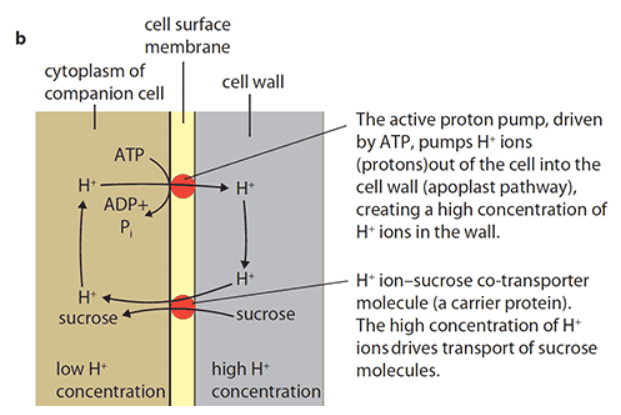AS Level Biology 9700
7. Transport in plants
Written by: Pranav I
Formatted by: Rithanya S
Formatted by: Rithanya S
7.1 The transport needs of plants
Plants make their own organic food via photosynthesis (mostly in leaves)
Absorb inorganic mineral ions and water from the soil (extensive root systems)
These materials must be transported to all parts of the plant
7.2 Vascular system: xylem and phloem
- Vascular system: A system of fluid-filled tubes, vessels or spaces used for long-distance transport in plants
- Contains xylem and phloem tissues
- Transported fluid is called sap
- Xylem transports water and inorganic mineral ions in xylem vessels → only one direction
- Phloem transports products of photosynthesis and substances from storage organs → occurs in different directions
7.3 Structure of stems, roots and leaves and the distribution of xylem and phloem
Dicotyledons
- A classification of flowering plants
- Their seeds contain an embryo with two cotyledons
- Adult plants have a leaf with a blade and a stalk
Low-power plan diagrams
✅ Rules
- Do not draw individual cells
- Draw all tissues completely enclosed by lines
- Draw a correct interpretation of the distribution of tissues
- A representative portion (of the TS or the micrograph) may be drawn
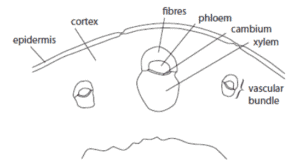
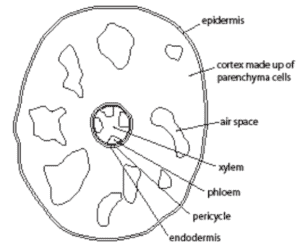
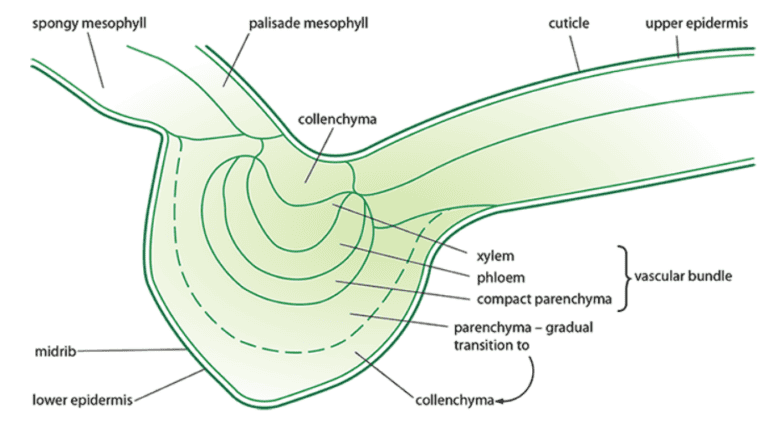
- The epidermis is one-cell thick and covers the outside of the plant
- Most cells outside the vascular bundle are parenchyma cells (in the cortex)
- Collenchyma cells have thicker walls compared to parenchyma cells and are found below the epidermis
- The endodermis is one-cell thick
- Sclerenchyma (cap of fibres) in stem vascular bundles for extra strength
High-power detailed diagrams
✅ Rules
- Draw only a few representative cells
- Draw the cell wall of all plants cells
- Do not draw the nucleus as a solid blob
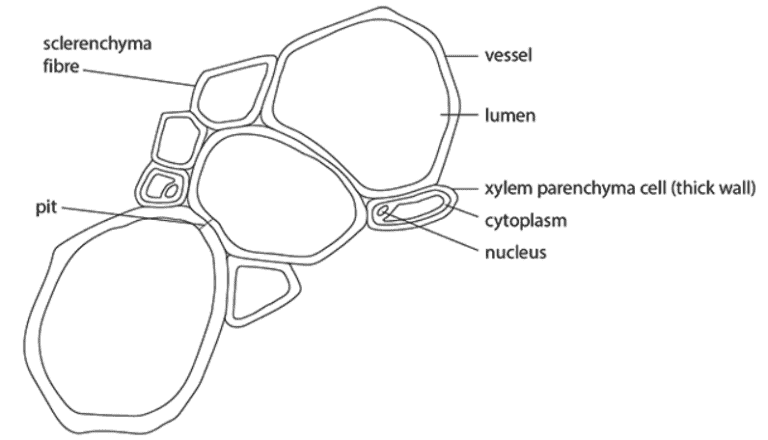

7.4 The transport of water
- Water always moves down a water potential gradient (higher water potential to lower water potential)
Transpiration
- Water from the walls of mesophyll cells evaporates into the air spaces
- Water vapour diffuses out of the leaf down the concentration gradient through stomata (mostly during the day)
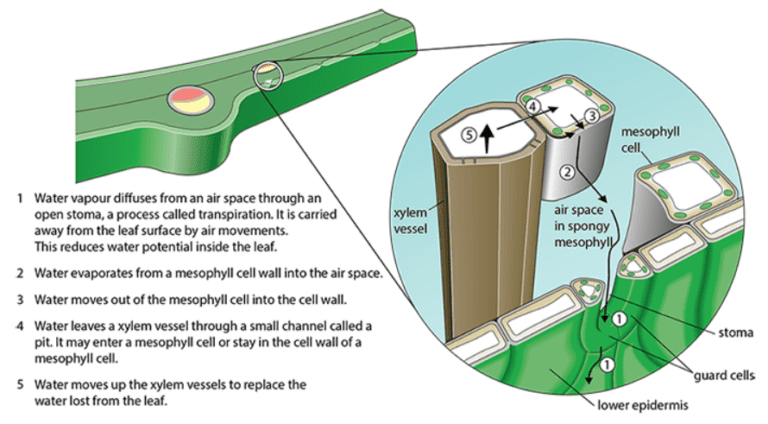
Xerophytes
- Plants that live in places where water is short in supply
| Adaptation | Function |
|---|---|
| Curled up leaves | |
| Thick, waterproof cuticle (made up of cutin, a fatty substance) | |
| Trichomes (tiny hair-like structures) | Helps trap a layer of moist air next to the surface |
| Leaves reduced to spines | Lesser surface area to reduce transpiration |
| Sunken stomata | Reduces the water potential gradient |
| Swollen, succulent stems | Store water |
Movement of water from xylem across the leaf
- Water is drawn from xylem vessels to replace the water that evaporates from the cell walls of mesophyll cells
- Symplast pathway: Cell to cell movement via the plasmodesmata (living system of interconnected protoplasts extending through a plant)
- Apoplast pathway: The non-living system of interconnected cell walls extending throughout a plant
Structure of xylem
- Xylem vessel element: A dead, lignified cell found in xylem specialised for transporting water and for support
- As lignin builds up around normal plant cells, the contents of the cell die
- End walls of the vessel elements break down completely to form a continuous tube (xylem vessel → xylem vessel elements lined up end-to-end)
- No lignin is laid down in plasmodesmata → appear as gaps in the thick walls of xylem vessels → Pits
- The pits in one cell line up with those in others
- Allow water to move into and out of vessels
- Note: They still have the original unthickened cell wall
Movement of water through xylem from root to leaf
- Transpiration creates tension in xylem vessels (negative pressure)
- Strong, lignified walls prevent xylem vessels from collapsing
- Water and mineral ions move up the xylem vessels by mass flow (all molecules move at the same speed)
- Cohesion: Water molecules are attracted to each other by hydrogen bonding
- Adhesion: Water molecules are attracted to hydrophilic cellulose and lignin in the walls of the xylem vessels
- The small diameter of xylem vessels prevents air locks from forming
Movement of water across the root from root hairs to xylem
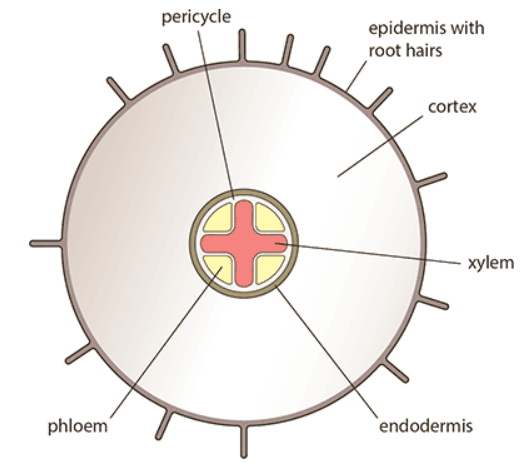
- Root hairs increase the surface area for absorption of water and mineral ions
- Water moves down a water potential gradient across the root through the cortex
- Symplast pathway: Water moves into the cytoplasm of a cortex cell by osmosis, and to neighbouring cells through the plasmodesmata, or adjacent cell surface membranes and cell walls
- Apoplast pathway: Water soaks into the cellulose cell walls, and moves across the root cell wall to cell wall
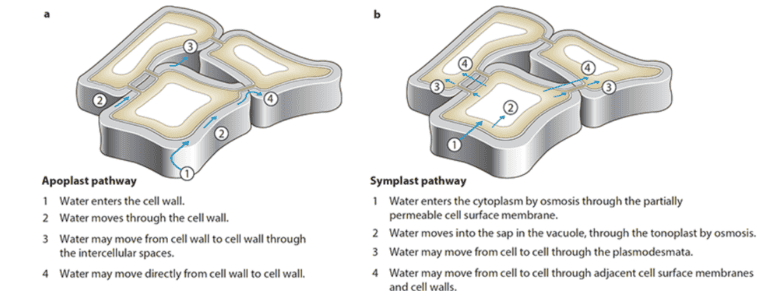
- At the endodermis, the apoplast pathway is blocked
- Cells in the endodermis have a thick, waterproof, waxy band of suberin in their cell walls (Casparian strip) → goes around each cell
- Passage cells in the endodermis keep the symplast pathway open
- Water moves into xylem vessels through pits
Movement of water from the soil into root hairs
- Root hairs are extensions of some of the epidermal cells of the root
- Moves into root hairs by osmosis down a water potential gradient
- Increase surface area for absorption → increase rate of absorption
7.5 Transport of assimilates
- Assimilates: Chemical compounds made by the plant as a result of assimilation (eg: sucrose and amino acids)
- They are transported from sources to sinks in the phloem
- Source: A site in a plant which provides food for another part of the plant
- Sink: A site in a plant which receives food from another part of the plant (for growth, development and/or storage)
Structure of phloem
- Consist of sieve tube elements and companion cells → form functional units
- Sieve tube elements and sieve tubes
- Made of living cells → have no nucleus, tonoplast or ribosomes
- Contains a cellulose cell wall, cell surface membrane and cytoplasm (thin layer lining the inside of the cell wall)
- Elongated in shape
- A sieve plate is formed where the end walls of two sieve tube elements meet → perforated by large, open sieve pores
- Has at least one companion cell beside it
- More mitochondria and ribosomes than usual
- Dense cytoplasm
- Metabolically very active
- Other features of a typical plant cell
- Numerous plasmodesmata pass through the cell walls of sieve tube elements and their companion cell(s)
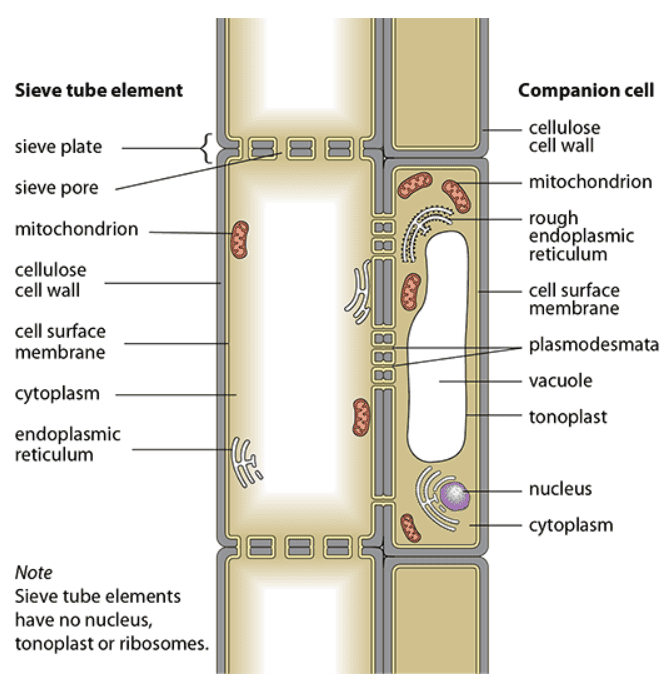
- The contents of phloem sieve tubes
- Phloem sap contains sucrose, amino acids and inorganic ions
- How transport occurs in sieve tubes
- Phloem sap moves by mass flow → an active process in this case (requires energy to create pressure differences)
- Pressure difference is created by the active loading of sucrose into the sieve tube elements at the source
- This reduces the water potential of the phloem sap
- Water enters the sieve tube element by osmosis
- Causes a build-up of pressure inside the sieve tube element
- This is hydrostatic pressure
- The hydrostatic pressure gradient (pressure difference) causes the mass flow of water and solutes from source to sink
- When sucrose is removed at the sink, water then moves out by osmosis → reduces hydrostatic pressure (maintains the pressure difference)
- Phloem sap can flow both upwards and downwards
- Loading sucrose into phloem
- Hydrogen ions are pumped out of the companion cell into its cell wall by a proton pump using ATP → excess of H+ ions in the apoplast pathway
- The H+ ions can move back into the cell by passive diffusion through the H+ ion–sucrose cotransporter protein
- A cotransporter is a carrier protein that transports two substances at the same time (will only work if both molecules move through it together)
- Sucrose molecules are carried into the companion cell along with the H+ ions through the cotransporters, against their concentration garadient
- Sucrose molecules diffuse into the sieve tube from the companion cells via the plasmodesmata
